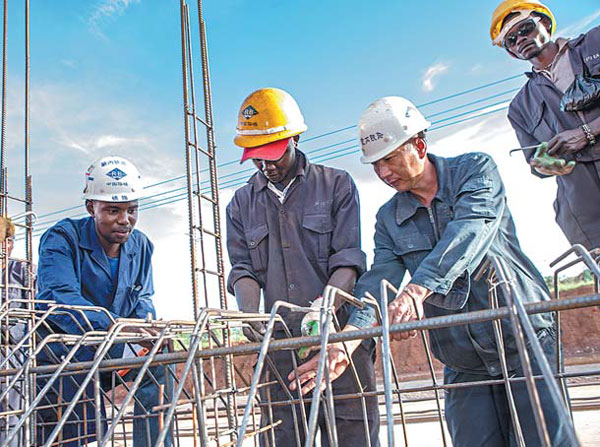Train of thought leads to change of direction
Updated: 2015-06-12 06:41
By Hou Liqiang(China Daily Europe)
|
|||||||||||
A couple of years ago Wilfred Githuka Gachugi, a student at Kenyatta University in Kenya, took a high-speed train in China for the first time. As he was being whisked the 1,000 kilometers from Guangzhou to Wuhan it occurred to him that it would be great if Kenya had good train service.
At the time, Gachugi, then 25, was studying Chinese at Nanjing University of Chinese Medicine with the help of a Chinese government scholarship. Earlier he had studied Chinese at a Confucius Institute in Kenya for six months.
Much to his surprise, not only is his wish for his country to have modern rail service on the verge of being realized, but he is also playing a direct role in making that happen.
|
Wilfred Githuka Gachugi (left) interprets at the construction camp. |
The China Road and Bridge Corporation won the tender to build the Mombasa-Nairobi Standard Gauge Railway at a cost of $3.8 billion and started work on it last year.
Last year his former Chinese teacher in the Confucius Institute, who joined CRBC, got in touch with him and asked if he would like to work as an interpreter on the railway project in a factory in which sleepers and T-shaped girders are being made. Those working there are mostly from Masai and Kamba communities and speak only Swahili and their mother languages, but no English.
"I accepted the offer with no hesitation once I heard who the offer was from," Gachugi says.
Wearing a cardboard hat he made, he showed up at a work site camp one day, a little hesitant, he says, because he had not worked as an interpreter before.
To help Chinese technicians recognize him, he wrote "Fanyi", meaning interpreter, on his hat in Chinese characters. Gradually, he has developed a good relationship with the Chinese workers there, he says, and they call him Yang, a short form of his Chinese name, Chu Dayang.
His task is made all the more difficult because of the technical language often used and the various dialects of those dealing with one another.
He says he takes photographs of objects whose names he does not know in English and sends them to his girlfriend, who is Chinese and who works for a Chinese company in Ethiopia. They met when he was learning Chinese in China, he says.
When he is working, his constant companion is a notebook in which are clearly written Chinese characters with pronunciation guides accompanying them.
"I write down the Chinese I don't know and then practice in the evening. When I interpret, I raise questions and learn a lot from Chinese."
The Kenyans he works with enjoy their jobs because "they can not only make money but learn skills", he says."Many come looking to work here because they think the experience in building the railway will guarantee them a job after the train comes. They really enjoy the work. Earlier, they had no chance to pick up skills, but now they do and they have learned how to do the work.
"I would like to take the first train after the railway is completed."
He expects that in 15 years a railway will be completely designed and built by Kenyans, he says. Gachugi says he always took photos when he was on trains in China. He has carried that photography habit into the camp and has established a website to show what is happening on the construction site.
"Many Kenyans don't have the chance to see this," he says.
"I want to show it to them."
He has a website in China on which he talks about his experience in learning Chinese.
Gachugi says he hopes to continue his studies in China, where he will major in electrical engineering,
"I want to be the best engineer in Kenya and help to build the railway and the power grid."
He says he found himself captivated by China's project, Chinese brush writing and Chinese people. He practices calligraphy at least three times a week, he says.
"Chinese are great in doing many things. I like Chinese because many things are made in China. Everything I use is made in China."
(China Daily European Weekly 06/12/2015 page16)
Today's Top News
Zhou Yongkang sentenced to life in prison
Kiev announces new round of peace talks on Ukraine crisis
Greece, EU powers agree to step up debt talks as crunch looms
EU sanctions hamper Italian-Russian commercial ties: Putin
Suu Kyi begins groundbreaking visit
G7 'ignore the facts over South China Sea'
British PM hails 'golden year' in UK-China relations
China's new rail giant bags first overseas deal from India
Hot Topics
Lunar probe , China growth forecasts, Emission rules get tougher, China seen through 'colored lens', International board,
Editor's Picks

|

|

|

|

|

|







